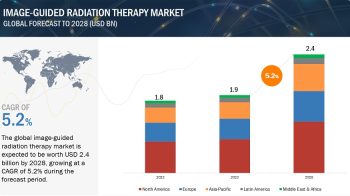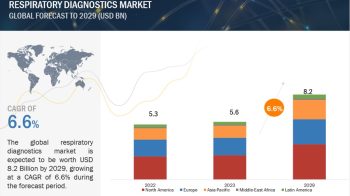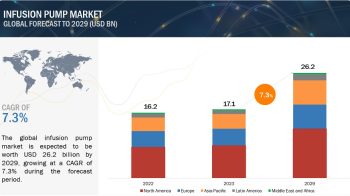Overview of This Study:
This study involved four major activities for estimating the current size of the global Respiratory Care Device Market. Exhaustive secondary research was conducted to collect information on the market as well as its peer and parent markets.
The next step focused on validating these findings, assumptions, and sizing with industry experts across the value chain through primary research. Both the top-down and bottom-up approaches were employed to estimate the complete market size. After that, market breakdown and data triangulation were used to estimate the sizes of segments and sub-segments.
Expected Growth in Revenue Generation:
The respiratory care devices market is expected to reach USD 27.6 billion by 2026 from USD 18.4 billion in 2021, at a CAGR of 8.5% during the forecast period of 2021 to 2026.
Data Triangulation:
After arriving at the overall market size—using the market size estimation processes explained above—the market was split into several segments and sub-segments. To complete the overall market engineering process and arrive at the exact statistics of each market segment and sub-segment, the data triangulation and market breakdown procedures were employed, wherever applicable. The data was triangulated by studying various factors and trends from both the demand and supply sides.
Drivers: Outbreak of infectious diseases affecting the respiratory system
Infectious respiratory diseases directly drive demand for respiratory care. COVID-19 is the most recent and significant of these diseases; the pandemic has resulted in a surge in demand for personal protection equipment and ventilators, among others. The demand for ventilators has also grown due to the COVID-19 outbreak, resulting in governmental and industrial support for driving the pace of manufacturing. This is indicative of the emphasis on respiratory care in the background of an outbreak; the market is expected to show a healthy growth rate, as a result.
Download PDF Brochure@
https://www.marketsandmarkets.com/pdfdownloadNew.asp?id=368
Recent Developments Respiratory Care Device Market:
# In April 2020, Philips launched the PHILIPS RESPIRONICS E30 VENTILATOR. This will enable company to help healthcare professionals by providing superior quality ventilators.
# In January 2020, Masimo Corporation acquired Connected Care Business from NantHealth (US). This acquisition will support Masimo to assist hospitals in providing constant care through connectivity, automation, and innovative noninvasive monitoring technologies.
# In May 2020, Philips did the partnership with Masimo. This partnership was aimed at integrating Masimo’s measurement technologies into select intellivue MX-Series multi-parameter monitors to help clinicians examine ventilation status and cerebral oximetry.
# In March 2019, ResMed acquired HB Healthcare Safety, a provider of home-based medical equipment for sleep and respiratory care devices.
Restrains: Unfavorable reimbursement scenario
Many patients rely on reimbursements to receive treatment. The diagnostic industry as a whole and respiratory care diagnostics, in particular, is presently facing the challenge of lack of reimbursements for various diagnostic tests. Reimbursement policies are dispersed in Europe and are available only for PAP devices and oral appliances in select countries (devices that are not covered by insurance have a low market share in the region). Also, the majority of countries in the Asian and RoW regions have negligible reimbursement coverage for respiratory care devices.
Opportunities: Growing demand for home care therapeutic devices
The rapid growth in the global geriatric population, rising incidence of chronic diseases (including COPD and asthma), and the cost advantages of home care devices and services (compared to hospital visits) are the key factors driving the growth of the home healthcare market. The high growth potential in emerging markets, healthcare decentralization, and the evolution of miniaturized devices are some of the major factors that are expected to provide significant growth opportunities to players operating in the respiratory home healthcare market.
Owing to the rising healthcare costs, a large number of patients suffering from chronic respiratory diseases prefer to undergo treatments in home care settings. This trend is expected to increase the demand for products such as nebulizers, ventilators, and CPAP devices, as they are used by patients to treat, diagnose, and monitor a variety of respiratory diseases in home care settings.
Challenges: Low awareness and large underdiagnosed and undertreated population
In spite of the high prevalence of major respiratory diseases such as asthma and COPD remain highly underdiagnosed and undertreated. This is particularly evident in developing economies due to the low awareness about these diseases and the unavailability of adequate resources to diagnose these diseases. According to the WHO, more than 90% of COPD deaths and 80% of asthma deaths occur in low- and middle-income countries. COPD develops slowly, and it is usually diagnosed in people aged over 40 years, which makes it difficult to control in the later stages of life.
It is estimated that around 70% of COPD patients are underdiagnosed owing to the lack of awareness about the disease. Similar to COPD, asthma is also a highly underdiagnosed and undertreated disease (in around 50% asthmatics).
Request Sample Pages@
https://www.marketsandmarkets.com/requestsampleNew.asp?id=368


